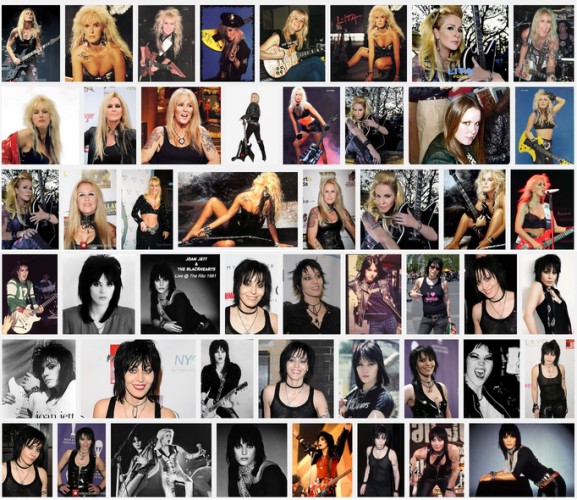Joan Jett, Lita Ford, and the Twilight of the American Hard-Rock Woman

You'll notice something about gender-demographics in media that's a little creepy when you think about it: When men market to women, they hide the men and paint everything pink - but the entire set-up is based on what men think women should want, seemingly without the input of even one human being born with two X chromosomes. When women market to men, the woman is always pasted in front, dressed in as little as possible, and the woman goes out of her way to act as stereotypically male as possible.
Summary take-away message this sends:
* Men want a woman who is dis-empowered by being forced to play at the advantaged masculine level, and stripped of every possible sign of her femininity save her puffy girly parts.
* Women want two pink aisles of every store all to their own, and will settle for whatever the guys are having but color-coded for their convenience.
Just take a look at the history of women in male-marketed rock 'n' roll:
- Suzi Quatro
- Pat Benatar
- Lita Ford (what? not indexed yet?)
- The Runaways (what? not indexed yet?)
And of course, Joan Jett.
Here's a screenshot of Google images when we search for "Lita Ford" or "Joan Jett":

Are you beginning to see the pattern? It's as if neither of them have ever worn anything but black a day in their lives. Black leather, black velvet, black rubber, black black. Guys like women in black, preferably with lots of tattoos and posing with their hips thrust forward like they're about to pee standing up. The sole exception is when Joan takes to the stage iiiiiiinnnnn.... a FOOTBALL jersey. What would happen if either of the gals did a set with a flowered muumuu and Birkenstocks and big chunky earrings one time? The male audience would get up and walk out (with their loyal girlfriends behind them), because now she'd be packaged differently, even though same songs, same band, same performer. KISS can wipe off their makeup and still be KISS. Lita Ford without five coats of Playboy-centerfold camouflage becomes one of those icky girly girl bands like The Bangles or Siouxsie and the Banshees, ew!
Women rockers marketed to men even all have to sing alto, and a hard-pounding, WWF-announcer alto at that. Because men cannot hear tones higher than 440 Hz, amiright?
All this is prelude by way of pointing out the fact that Joan Jett and Lita Ford are still touring, still singing, still releasing albums, and still wearing the ol' traditional. And if you're surprised at this news, it's because the era of the male-marketed female hard-rocker ended a long time ago. But back it up a bit...
The story of Joan Jett and Lita Ford begins with The Runaways, and here's their signature hit "Cheery Bomb":
Hey, look, it's five women wearing black and singing alto, playing heavy punkish rock. Only the lead (Cherie Currie) has to appear more glamorous, so she gets center front and the sequinned black top... tied off to show as much skin as possible, of course. Just a few years ago, there was a fictionalized documentary about the short history of The Runaways, titled The Runaways. They occupied that twilight cross between hard rock and punk when rock-music culture couldn't decide where it wanted to go next in the late '70s and they had to have something for the people who were sick of disco and funk. Far more telling is the 2005 documentary Edgeplay, a term borrowed from BDSM culture - and quite adept at capturing the image The Runaways wanted to portray. The bridge was burned; there was no chance of making up with the female half of the music market now.
By 1980, there was no longer a Runaways, but most forged their own music careers, and they were mostly all quite seminal. Sandy West became a session musician with The Who. Micki Steele ran off to be a Bangle, showering off the nicotine-stained leather jacket smell. Cherie Currie wobbled between solo and joining Joan Jett's Blackheart Records label. Vicki Blue played a bit part in This Is Spinal Tap and a documentary about Suzi Quatro (who also wrote songs for The Runaways, we forgot to mention). Only McAllister and Fox moved on to non-music careers.
Lita Ford, we all know, went on to huge fame and success through the '80s onward, and this is probably her signature hit "Kiss Me Deadly":
And before we go anywhere, we have to compare Joan Jett, because this song came out at almost the same time and for all you could tell over anonymous radio, could have been sung by the same person. "I Hate Myself For Loving You":
So now we have the dueling heavy-leather boy's-fantasy altos, both being the sole whiff of estrogen in the campy, hairy sausage-fest that was the hard-rock / metal scene in the late '80s.
Now, of the two, Joan Jett has the biggest, ah, credentials here. You'll remember that she covered The Arrows' "I Love Rock and Roll" in 1982, and holy monkey gods of Pluto, did that song ever become a worldwide hit. In case you're too young to remember it, here is the video:
Yes, that's her previous release "Bad Reputation" playing at the beginning, which was part of her album of the same title released in 1980. It didn't go anywhere special, but the reputation of this song rubbed off on "Bad Reputation" to where VH1 now declares it a classic.
Suzi Quatro had a great deal of involvement in the early Runaway days, and to this day every female who ever dressed like Batman's centerfold fantasy while grunting into a microphone owes a debt to her. She's the godmother of the hell-for-leather gals. Just look at her here in "Can the Can", her first UK #1 single:
Hey, look! It's a woman in black... Oh forget it, you know the words by now.
Oh, she didn't chart top-40 in the US, not until 1978's mellow lounge lovey-dovey duet with Chris Norman, "Stumblin' In." See, "Can the Can" was released in 1973, and Suzi was a hit in the UK and Australia for many years before she broke the ice stateside. 1973 was too early for Americans to deal with a woman inspired by Elvis. The Runaways ran away with Quatro's shtick, and turned it from a cross-gender appeal (in UK and AU) to an almost exclusively masculine demographic. And yes, Madonna might have raised an eyebrow in the US with her fetish-wear by the '80s, but in 1973 UK audiences didn't appear fazed by Quatro's leather dog collar with dangling tag.
Oh, yeah, one more thing. Quatro's still touring.

 Buy the Soundtrack, Skip the Movie: Brainscan (1994)
Buy the Soundtrack, Skip the Movie: Brainscan (1994)  Let’s Go to the Hop - Ignore That Door’s Four Bunnie...
Let’s Go to the Hop - Ignore That Door’s Four Bunnie...  Forgotten Weird Music Videos of the Ancient 80s | vol 3
Forgotten Weird Music Videos of the Ancient 80s | vol 3  Forgotten Weird Music Videos of the Ancient 80s | vol 2
Forgotten Weird Music Videos of the Ancient 80s | vol 2  Forgotten Weird Music Videos of the Ancient 80s | vol 1
Forgotten Weird Music Videos of the Ancient 80s | vol 1  Let’s Chase Taylor Swift Rumors
Let’s Chase Taylor Swift Rumors  When the Beatles Touched Off a Movie War
When the Beatles Touched Off a Movie War  When Mike Bloomfield Composed a Soundtrack For Andy ...
When Mike Bloomfield Composed a Soundtrack For Andy ...  Yet Another List of Bad Song Covers
Yet Another List of Bad Song Covers  Why Does Everybody Pick On Liberace?
Why Does Everybody Pick On Liberace?  Trainspotting Soundtrack Revisited : One of the Best...
Trainspotting Soundtrack Revisited : One of the Best...  Nicki Minaj and Megan Thee Stallion: Bringing Back t...
Nicki Minaj and Megan Thee Stallion: Bringing Back t...  Quirky Songs About Los Angeles
Quirky Songs About Los Angeles  Penguin Pete’s Obligatory Penguin Cafe Orchestra Post
Penguin Pete’s Obligatory Penguin Cafe Orchestra Post  Heart | How Bad Are Those Animals?
Heart | How Bad Are Those Animals?  That Time Ronnie James Dio Saved Black Sabbath’s Bacon
That Time Ronnie James Dio Saved Black Sabbath’s Bacon  What is a Left Hand Path? - Entombed and Swedish Dea...
What is a Left Hand Path? - Entombed and Swedish Dea...  Song Analysis Corner: Convoy (1975)
Song Analysis Corner: Convoy (1975)  What’s Up With Margaritaville?
What’s Up With Margaritaville?  This Album Links Duran Duran, Andy Warhol, and Kurt ...
This Album Links Duran Duran, Andy Warhol, and Kurt ...  Your Back-To-School Playlist
Your Back-To-School Playlist  Cucumber Castle | the other Bee Gees Movie
Cucumber Castle | the other Bee Gees Movie  Danny Elfman Scores New Film; Other Movie Weirdness!
Danny Elfman Scores New Film; Other Movie Weirdness!  Sparks Is Not Crying in Their Latte
Sparks Is Not Crying in Their Latte  Travis Scott : Rapper, Cannabis Entrepreneur, Filmmaker
Travis Scott : Rapper, Cannabis Entrepreneur, Filmmaker  Anders Runestad – Author and Music Blogger
Anders Runestad – Author and Music Blogger  What If They Really ARE Giants?
What If They Really ARE Giants?  Prince’s Underrated Under the Cherry Moon
Prince’s Underrated Under the Cherry Moon  Six Degrees of Blondie
Six Degrees of Blondie  Six Degrees of: Adam and the Ants
Six Degrees of: Adam and the Ants  Discovering Beat-Club | Vintage West German Music Show
Discovering Beat-Club | Vintage West German Music Show  Eurovision Contest Winners part 2
Eurovision Contest Winners part 2  Song Analysis Corner: Snoopy vs. the Red Baron | The...
Song Analysis Corner: Snoopy vs. the Red Baron | The...  Eurovision Contest Winners part 1
Eurovision Contest Winners part 1  KISS SUXX!
KISS SUXX!  You Haven’t Met Your Last Reefer Man
You Haven’t Met Your Last Reefer Man  Ruth Underwood and the “Zappa sound”
Ruth Underwood and the “Zappa sound”  Catchy Commercial Earworms | vol 2
Catchy Commercial Earworms | vol 2  Song Analysis Corner: “Trouble Every Day” | Frank Zappa
Song Analysis Corner: “Trouble Every Day” | Frank Zappa  Blues Music For Your Great Recession
Blues Music For Your Great Recession  We Can Fix America If We Just Bring Back Schoolhouse...
We Can Fix America If We Just Bring Back Schoolhouse...  Song Analysis Corner: Istanbul (Not Constantinople)
Song Analysis Corner: Istanbul (Not Constantinople)  Music To Shoot Down UFOs To
Music To Shoot Down UFOs To  Are You Ready For AI Music?
Are You Ready For AI Music?  How Dreary Was 1970s Adult Contemporary?
How Dreary Was 1970s Adult Contemporary?  I Just Called To Say Stevie Wonder's Song Deserved a...
I Just Called To Say Stevie Wonder's Song Deserved a...  "Knock On Wood" | The Real Song To Remember From Cas...
"Knock On Wood" | The Real Song To Remember From Cas...  Dr. Dre's Not Gonna Take This Anymore
Dr. Dre's Not Gonna Take This Anymore  Apache - The Shadows | A Surf-Rock Safari
Apache - The Shadows | A Surf-Rock Safari  New Year : New Music Artists You (Probably) Haven't ...
New Year : New Music Artists You (Probably) Haven't ...  Song Odyssey | I Put A Spell on You
Song Odyssey | I Put A Spell on You  KMart and S.S. Kresge | Music Mystery?
KMart and S.S. Kresge | Music Mystery?  Did I Ever Introduce You To Horrorpunk?
Did I Ever Introduce You To Horrorpunk?  Song Analysis Corner : The Coffee Song
Song Analysis Corner : The Coffee Song  Duran Duran Finally Got Inducted
Duran Duran Finally Got Inducted  That Time Taylor Swift Broke Ticketmaster
That Time Taylor Swift Broke Ticketmaster  Parody Songs and Lawsuits | Of Interest To Aspiring ...
Parody Songs and Lawsuits | Of Interest To Aspiring ...  Worst Band Spats
Worst Band Spats  Rock and Roll Bookshelf | Corey Taylor's Seven Deadl...
Rock and Roll Bookshelf | Corey Taylor's Seven Deadl...  Lizzo, the Flute, and Racist-Sexist Republican Fallout
Lizzo, the Flute, and Racist-Sexist Republican Fallout 